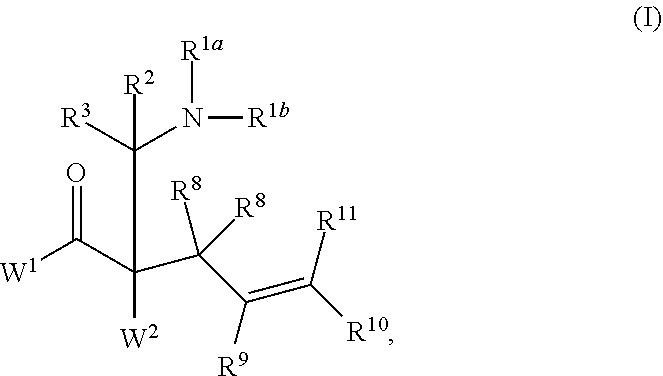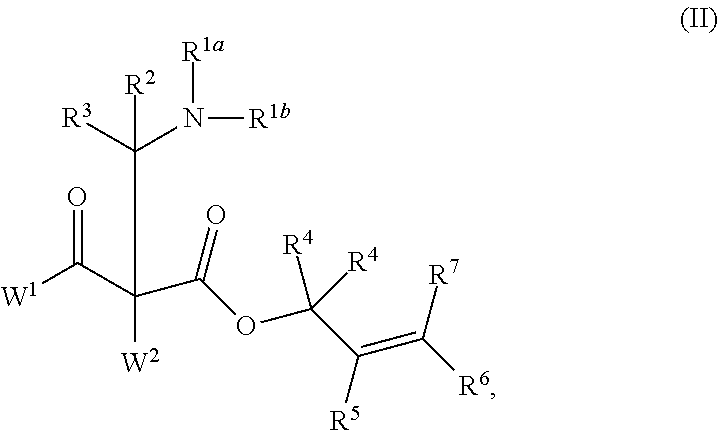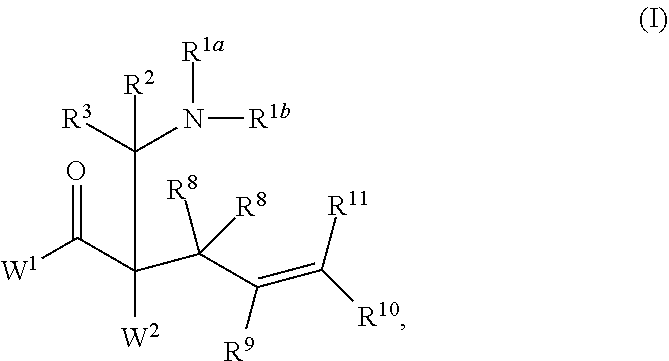Enantioselective synthesis of alpha-quaternary mannich adducts by palladium-catalyzed allylic alkylation
a technology of allylic alkylation and enantioselective synthesis, which is applied in the field of enantioselective synthesis of alphaquaternary mannich adducts by palladiumcatalyzed allylic alkylation, can solve the problems of asymmetric mannich-type reactions to establish -quaternary carbonyl compounds that are limited to specialized substrate classes
- Summary
- Abstract
- Description
- Claims
- Application Information
AI Technical Summary
Benefits of technology
Problems solved by technology
Method used
Image
Examples
example 1
ative Synthesis for Preparation of α-Aminomethyl 1,3-dicarbonyl Substrate
[0221]To introduce the aminomethyl moiety, sulfonylmethyl carbamates (e.g., 2a) were employed as versatile and readily available imine precursors. In the presence of Cs2CO3, the Boc-protected imine generated from 2 reacted with β-keto ester 1 to smoothly afford β-aminoketone 3a, quantitatively, at ambient temperature. In a similar manner, other protected aminoketones 3b-g were obtained in good to excellent yields.
Representative Procedure A
[0222]
[0223]Allyl 1-(((tert-butoxycarbonyl)amino)methyl)-2-oxocyclohexane-1-carboxylate (3a). To a stirred solution of β-keto ester 1 (0.91 g, 5.0 mmol, 1 equiv) in CH2Cl2 (25 mL) was added sulfonylmethyl carbamate 2a (1.63 g, 6.0 mmol, 1.2 equiv) in one portion at ambient temperature. After stirring for 5 min, Cs2CO3 (4.70 g, 12.5 mmol, 2.5 equiv) was added in one portion. After 12 h, full consumption of starting material was determined by TLC analysis. Saturated aqueous ammo...
example 2
ative Procedure for Palladium-Catalyzed Allylic Alkylation
[0239]With β-keto esters 3a-g in hand, this substrate class was investigated in the context of palladium-catalyzed allylic alkylation as shown in Table 1. Exposure of Boc-protected substrate 3a to a catalytic phosphinooxazolinepalladium(0) complex in toluene at ambient temperature afforded the desired product 4a in 94% yield and 86% ee (entry 1). Cbz-protected 3b also gave excellent yield and ee (entry 2). It is important to note that no N-alkylated side products were detected, a result that highlights the mild nature of these reaction conditions. Arylcarbamates 3c-e gave slightly decreased enantioselectivities in the products (entries 3-5). We also examined benzoyl and tosyl protecting groups.
TABLE 1Optimization of the Amine Protecting Group.aentryR (3 → 4)yield (%)ee (%)b1Boc (3a → 4a)94862Cbz (3b → 4b)96863 4 5X = OMe (3c → 4c) X = H (3d → 4d) X = F (3e → 4e)91 90 8483 77 776Bz (3f → 4f)NDc567Ts (3g → 4g)5424aReaction perf...
example 3
or Determining Enantiomeric Excess and Optical Rotation of Alkylation Products
[0259]
TABLE S-1entrycompoundanalytic conditionsee (%)polarimetry1SFC: 5% IPA, 2.5 mL / min Chiralpak AD-H, λ = 210 nm tR (min): major 3.73, minor 4.3086[α]D25 − 25.5 (c 0.865, C6H6)4a2SFC: 5% IPA, 2.5 mL / min Chiralpak AD-H, λ = 210 nm tR (min): major 8.12, minor 9.0686[α]D25 − 38.6 (c 1.20, CHCl3)4b3SFC: 10% IPA, 2.5 mL / min Chiralcel OB-H, λ = 210 nm tR (min): major 9.47, minor 11.1383[α]D25 − 29.3 (c 0.76, CHCl3)4c4SFC: 10% IPA, 2.5 mL / min Chiralcel OB-H, λ = 210 nm tR (min): major 6.53, minor 8.1377[α]D25 − 28.9 (c 0.40, CHCl3)4d5SFC: 10% IPA, 2.5 mL / min Chiralpak AS-H, λ = 210 nm tR (min): major 6.94, minor 8.2477[α]D25 − 27.4 (c 0.78, CHCl3)4e6SFC: 20% IPA, 2.5 mL / min Chiralpak AD-H, λ = 210 nm tR (min): major 4.04, minor 4.9156Specific Rotation Not Determined4f7SFC: 15% IPA, 2.5 mL / min Chiralcel OJ-H, λ = 210 nm tR (min): major 3.14, minor 3.8524Specific Rotation Not Determined4g
TABLE S-2entrycompoundan...
PUM
| Property | Measurement | Unit |
|---|---|---|
| temperature | aaaaa | aaaaa |
| ambient temperature | aaaaa | aaaaa |
| reaction temperature | aaaaa | aaaaa |
Abstract
Description
Claims
Application Information
 Login to View More
Login to View More - R&D
- Intellectual Property
- Life Sciences
- Materials
- Tech Scout
- Unparalleled Data Quality
- Higher Quality Content
- 60% Fewer Hallucinations
Browse by: Latest US Patents, China's latest patents, Technical Efficacy Thesaurus, Application Domain, Technology Topic, Popular Technical Reports.
© 2025 PatSnap. All rights reserved.Legal|Privacy policy|Modern Slavery Act Transparency Statement|Sitemap|About US| Contact US: help@patsnap.com



